Control practices statement-DS5
性能验证ppt课件

5.3.2.7 应保存影响检验性能的每一试剂和耗材的记录,包括但不限于
试剂和耗材 以下内容:
-记录
h) 证实试剂或耗材持续可使用的性能记录。
微生物专业要求:
5.3.2.3 试剂和耗材验收试验应符合如下要求: (a) 新批号及每一货次试剂和耗材使用前,应通过直接分析参考物质、新旧批号平行实验或常规 质控等方法进行验证,并记录; (b) 新批号及每一货次试剂和耗材,如吲哚试剂,杆菌肽,奥普托辛,X、V、XV 因子纸片等应 使用阴性和阳性质控物进行验证; (c) 新批号及每一货次的药敏试验纸片使用前应以标准菌株进行验证; (d) 新批号及每一货次的染色剂(革兰染色、特殊染色和荧光染色)应用已知阳性和阴性(适用 时)的质控菌株进行验证; (e) 新批号及每一货次直接抗原检测试剂(无论是否含内质控)应用阴性和阳性外质控进行验证 ;
生物参考区间验证及评审:20份健康人标本,生物参考区间的评 审还应该有临床医生的参与。评审内容:生物参考区间的来源、 针对的人群、生物参考区间验证结果、与临床诊断的符合性等。
生物参考区间建立:120份健康人标本
10
应用准则对方法学性能的通用要求(2)
通过与其他实验室(如已获认可的实验室、使用相同检测方法的 实验室、使用配套系统的实验室)比对的方式确定检验结果的可 接受性时,应满足如下要求:
免疫定性试验:应按照制造商的说明或定义定期评审临界值或阈值 (CUT OFF值)。(5.5.5)
如制造商无相关的说明或定义,可以选择以下方法之一验证:
➢ 阴性来源:选择没有疾病的健康人和非讨论疾病患者的病人的新鲜血清共 120份,分3-5批3-5天进行检测,计算X、s,CUT OFF验证值为:X+3s;
EP14-A2: Evaluation of matrix effects; Approved Guideline-Second Edition.
美国CLIA88临床检验室内质量控制文件

美国CLIA88临床检验室内质量控制文件第一篇:美国CLIA88临床检验室内质量控制文件美国CLIA’88临床检验各专业室内质量控制文件(一)美国CLIA’88质量控制要求美国临床实验室改进修正法案最终规则(CLIA final rule)于2003年1月24日通过,2003年4月24日实施。
其中K-非豁免试验的质量体系,分析系统中493.1256标准:控制程序(control procedures)对各专业质量控制提出具体要求。
1、控制程序根据美国CLIA’88最终规则Sec.493.1256标准:控制程序(a)对于每一检测系统,实验室负责制定控制程序,监测整个分析过程的准确度和精密度。
(b)实验室必须建立检测控制物的数量、类型和频率,如果适合,实验室应按Sec.493.1256(b)(3)规定验证或建立性能规范。
(c)控制程序必须(1)立即检测出由于检测系统故障、不利的环境条件及操作者性能而产生的误差。
(2)长期监测由于检测系统性能和环境条件改变和操作者性能变化而可能影响到的准确度和精密度性能。
(d)除了CMS批准的程序,如国家操作手册附录C中规定(CMS Pub.7)的外,提供了等效质量检测,实验室必须(1)执行本节规定的质量控制程序,除非在493.1261到493.1278部分其他专业和亚专业有其他的规定。
(2)对于每一检测系统,当他们满足或超出本节(d)(3)部分要求时,执行的质量控制程序使用厂家规定或实验室建立的个数和频率。
(3)每天检测患者标本时至少每天检测一次控制品,或执行如下的步骤(i)每一定量检测程序,包括两个不同浓度水平的控制品;(ii)对每一定性的检测程序,包括一个阴性和一个阳性控制品;(iii)对于产生分级或滴度结果的检测程序,分别包括阴性控制品和具有分级或滴度反应性的控制品;(iV)对于具有提取阶段的每一检测系统,包括两个控制品,其中一种能够检出提取阶段的误差;(v)对于每一种分子扩增程序,包括两个控制品,如果反应抑制性是假阴性结果的显著性来源,一个控制品能够检出抑制性作用。
《ISPE 调试和确认(第二版)》全文解读
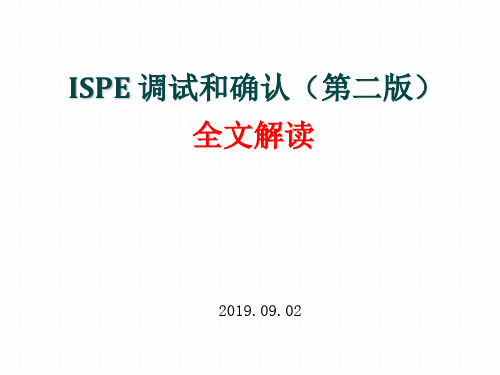
第6章
Part Two
调试和确认计划
36
C&Q计划
0 针对调试和确认活动指定单独的计划,这部分不再详 细介绍,可参照VMP的制定过程。
37
第7章
Part Two
C&Q测试及文件
38
测试和检查
39
测试/检查记录文件的示例选项
40
第8章
Part Two
接受和放行
41
接受和放行-案例1
测试文件完成
12
URS开发(ISPE原图翻译整理)
产品和工艺开发阶 段
需求和设计阶段
CQA
CPP
CA
产品和工艺需求 GMP法规要求 公司质量要求
URS
系统风险评估
设计标准
国际、当地和 工厂要求
商务/EHS/使 用者/SME要
求
工程和工业标 准
13
URS的分类(1)-延伸解读
项目URS
公共系统/设 施URS
消防系统 URS
7
适用范围
0 适用于人用及兽用药,包括生物制品等制造商所用的 系统。
0 不适用于医疗器械。 0 不包括:工艺及产品开发、计算机化系统软件开发及
测试(可参考ISPE GAMP 5)、工艺验证、清洁验证、 消毒和灭菌验证、分析方法验证、退市活动(可参考 ISPE 制药设备和设施退市指南)
8
该指南的流程概述和结构
29
第5章
Part Two
设计审核和设计确认
30
设计审核定义(ISPE引用ASTM E2500)
0 设计审核―在整个生产系统的生命周期中,有 计划、系统地对规范、设计、设计开发和持 续改进情况进行适当的回顾审查。设计审核 可根据标准和要求,交付评价,找出问题, 并提出必要的纠正措施。
3GPP TS 36.331 V13.2.0 (2016-06)
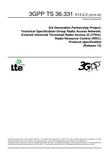
3GPP TS 36.331 V13.2.0 (2016-06)Technical Specification3rd Generation Partnership Project;Technical Specification Group Radio Access Network;Evolved Universal Terrestrial Radio Access (E-UTRA);Radio Resource Control (RRC);Protocol specification(Release 13)The present document has been developed within the 3rd Generation Partnership Project (3GPP TM) and may be further elaborated for the purposes of 3GPP. The present document has not been subject to any approval process by the 3GPP Organizational Partners and shall not be implemented.This Specification is provided for future development work within 3GPP only. The Organizational Partners accept no liability for any use of this Specification. Specifications and reports for implementation of the 3GPP TM system should be obtained via the 3GPP Organizational Partners' Publications Offices.KeywordsUMTS, radio3GPPPostal address3GPP support office address650 Route des Lucioles - Sophia AntipolisValbonne - FRANCETel.: +33 4 92 94 42 00 Fax: +33 4 93 65 47 16InternetCopyright NotificationNo part may be reproduced except as authorized by written permission.The copyright and the foregoing restriction extend to reproduction in all media.© 2016, 3GPP Organizational Partners (ARIB, ATIS, CCSA, ETSI, TSDSI, TTA, TTC).All rights reserved.UMTS™ is a Trade Mark of ETSI registered for the benefit of its members3GPP™ is a Trade Mark of ETSI registered for the benefit of its Members and of the 3GPP Organizational PartnersLTE™ is a Trade Mark of ETSI currently being registered for the benefit of its Members and of the 3GPP Organizational Partners GSM® and the GSM logo are registered and owned by the GSM AssociationBluetooth® is a Trade Mark of the Bluetooth SIG registered for the benefit of its membersContentsForeword (18)1Scope (19)2References (19)3Definitions, symbols and abbreviations (22)3.1Definitions (22)3.2Abbreviations (24)4General (27)4.1Introduction (27)4.2Architecture (28)4.2.1UE states and state transitions including inter RAT (28)4.2.2Signalling radio bearers (29)4.3Services (30)4.3.1Services provided to upper layers (30)4.3.2Services expected from lower layers (30)4.4Functions (30)5Procedures (32)5.1General (32)5.1.1Introduction (32)5.1.2General requirements (32)5.2System information (33)5.2.1Introduction (33)5.2.1.1General (33)5.2.1.2Scheduling (34)5.2.1.2a Scheduling for NB-IoT (34)5.2.1.3System information validity and notification of changes (35)5.2.1.4Indication of ETWS notification (36)5.2.1.5Indication of CMAS notification (37)5.2.1.6Notification of EAB parameters change (37)5.2.1.7Access Barring parameters change in NB-IoT (37)5.2.2System information acquisition (38)5.2.2.1General (38)5.2.2.2Initiation (38)5.2.2.3System information required by the UE (38)5.2.2.4System information acquisition by the UE (39)5.2.2.5Essential system information missing (42)5.2.2.6Actions upon reception of the MasterInformationBlock message (42)5.2.2.7Actions upon reception of the SystemInformationBlockType1 message (42)5.2.2.8Actions upon reception of SystemInformation messages (44)5.2.2.9Actions upon reception of SystemInformationBlockType2 (44)5.2.2.10Actions upon reception of SystemInformationBlockType3 (45)5.2.2.11Actions upon reception of SystemInformationBlockType4 (45)5.2.2.12Actions upon reception of SystemInformationBlockType5 (45)5.2.2.13Actions upon reception of SystemInformationBlockType6 (45)5.2.2.14Actions upon reception of SystemInformationBlockType7 (45)5.2.2.15Actions upon reception of SystemInformationBlockType8 (45)5.2.2.16Actions upon reception of SystemInformationBlockType9 (46)5.2.2.17Actions upon reception of SystemInformationBlockType10 (46)5.2.2.18Actions upon reception of SystemInformationBlockType11 (46)5.2.2.19Actions upon reception of SystemInformationBlockType12 (47)5.2.2.20Actions upon reception of SystemInformationBlockType13 (48)5.2.2.21Actions upon reception of SystemInformationBlockType14 (48)5.2.2.22Actions upon reception of SystemInformationBlockType15 (48)5.2.2.23Actions upon reception of SystemInformationBlockType16 (48)5.2.2.24Actions upon reception of SystemInformationBlockType17 (48)5.2.2.25Actions upon reception of SystemInformationBlockType18 (48)5.2.2.26Actions upon reception of SystemInformationBlockType19 (49)5.2.3Acquisition of an SI message (49)5.2.3a Acquisition of an SI message by BL UE or UE in CE or a NB-IoT UE (50)5.3Connection control (50)5.3.1Introduction (50)5.3.1.1RRC connection control (50)5.3.1.2Security (52)5.3.1.2a RN security (53)5.3.1.3Connected mode mobility (53)5.3.1.4Connection control in NB-IoT (54)5.3.2Paging (55)5.3.2.1General (55)5.3.2.2Initiation (55)5.3.2.3Reception of the Paging message by the UE (55)5.3.3RRC connection establishment (56)5.3.3.1General (56)5.3.3.1a Conditions for establishing RRC Connection for sidelink communication/ discovery (58)5.3.3.2Initiation (59)5.3.3.3Actions related to transmission of RRCConnectionRequest message (63)5.3.3.3a Actions related to transmission of RRCConnectionResumeRequest message (64)5.3.3.4Reception of the RRCConnectionSetup by the UE (64)5.3.3.4a Reception of the RRCConnectionResume by the UE (66)5.3.3.5Cell re-selection while T300, T302, T303, T305, T306, or T308 is running (68)5.3.3.6T300 expiry (68)5.3.3.7T302, T303, T305, T306, or T308 expiry or stop (69)5.3.3.8Reception of the RRCConnectionReject by the UE (70)5.3.3.9Abortion of RRC connection establishment (71)5.3.3.10Handling of SSAC related parameters (71)5.3.3.11Access barring check (72)5.3.3.12EAB check (73)5.3.3.13Access barring check for ACDC (73)5.3.3.14Access Barring check for NB-IoT (74)5.3.4Initial security activation (75)5.3.4.1General (75)5.3.4.2Initiation (76)5.3.4.3Reception of the SecurityModeCommand by the UE (76)5.3.5RRC connection reconfiguration (77)5.3.5.1General (77)5.3.5.2Initiation (77)5.3.5.3Reception of an RRCConnectionReconfiguration not including the mobilityControlInfo by theUE (77)5.3.5.4Reception of an RRCConnectionReconfiguration including the mobilityControlInfo by the UE(handover) (79)5.3.5.5Reconfiguration failure (83)5.3.5.6T304 expiry (handover failure) (83)5.3.5.7Void (84)5.3.5.7a T307 expiry (SCG change failure) (84)5.3.5.8Radio Configuration involving full configuration option (84)5.3.6Counter check (86)5.3.6.1General (86)5.3.6.2Initiation (86)5.3.6.3Reception of the CounterCheck message by the UE (86)5.3.7RRC connection re-establishment (87)5.3.7.1General (87)5.3.7.2Initiation (87)5.3.7.3Actions following cell selection while T311 is running (88)5.3.7.4Actions related to transmission of RRCConnectionReestablishmentRequest message (89)5.3.7.5Reception of the RRCConnectionReestablishment by the UE (89)5.3.7.6T311 expiry (91)5.3.7.7T301 expiry or selected cell no longer suitable (91)5.3.7.8Reception of RRCConnectionReestablishmentReject by the UE (91)5.3.8RRC connection release (92)5.3.8.1General (92)5.3.8.2Initiation (92)5.3.8.3Reception of the RRCConnectionRelease by the UE (92)5.3.8.4T320 expiry (93)5.3.9RRC connection release requested by upper layers (93)5.3.9.1General (93)5.3.9.2Initiation (93)5.3.10Radio resource configuration (93)5.3.10.0General (93)5.3.10.1SRB addition/ modification (94)5.3.10.2DRB release (95)5.3.10.3DRB addition/ modification (95)5.3.10.3a1DC specific DRB addition or reconfiguration (96)5.3.10.3a2LWA specific DRB addition or reconfiguration (98)5.3.10.3a3LWIP specific DRB addition or reconfiguration (98)5.3.10.3a SCell release (99)5.3.10.3b SCell addition/ modification (99)5.3.10.3c PSCell addition or modification (99)5.3.10.4MAC main reconfiguration (99)5.3.10.5Semi-persistent scheduling reconfiguration (100)5.3.10.6Physical channel reconfiguration (100)5.3.10.7Radio Link Failure Timers and Constants reconfiguration (101)5.3.10.8Time domain measurement resource restriction for serving cell (101)5.3.10.9Other configuration (102)5.3.10.10SCG reconfiguration (103)5.3.10.11SCG dedicated resource configuration (104)5.3.10.12Reconfiguration SCG or split DRB by drb-ToAddModList (105)5.3.10.13Neighbour cell information reconfiguration (105)5.3.10.14Void (105)5.3.10.15Sidelink dedicated configuration (105)5.3.10.16T370 expiry (106)5.3.11Radio link failure related actions (107)5.3.11.1Detection of physical layer problems in RRC_CONNECTED (107)5.3.11.2Recovery of physical layer problems (107)5.3.11.3Detection of radio link failure (107)5.3.12UE actions upon leaving RRC_CONNECTED (109)5.3.13UE actions upon PUCCH/ SRS release request (110)5.3.14Proximity indication (110)5.3.14.1General (110)5.3.14.2Initiation (111)5.3.14.3Actions related to transmission of ProximityIndication message (111)5.3.15Void (111)5.4Inter-RAT mobility (111)5.4.1Introduction (111)5.4.2Handover to E-UTRA (112)5.4.2.1General (112)5.4.2.2Initiation (112)5.4.2.3Reception of the RRCConnectionReconfiguration by the UE (112)5.4.2.4Reconfiguration failure (114)5.4.2.5T304 expiry (handover to E-UTRA failure) (114)5.4.3Mobility from E-UTRA (114)5.4.3.1General (114)5.4.3.2Initiation (115)5.4.3.3Reception of the MobilityFromEUTRACommand by the UE (115)5.4.3.4Successful completion of the mobility from E-UTRA (116)5.4.3.5Mobility from E-UTRA failure (117)5.4.4Handover from E-UTRA preparation request (CDMA2000) (117)5.4.4.1General (117)5.4.4.2Initiation (118)5.4.4.3Reception of the HandoverFromEUTRAPreparationRequest by the UE (118)5.4.5UL handover preparation transfer (CDMA2000) (118)5.4.5.1General (118)5.4.5.2Initiation (118)5.4.5.3Actions related to transmission of the ULHandoverPreparationTransfer message (119)5.4.5.4Failure to deliver the ULHandoverPreparationTransfer message (119)5.4.6Inter-RAT cell change order to E-UTRAN (119)5.4.6.1General (119)5.4.6.2Initiation (119)5.4.6.3UE fails to complete an inter-RAT cell change order (119)5.5Measurements (120)5.5.1Introduction (120)5.5.2Measurement configuration (121)5.5.2.1General (121)5.5.2.2Measurement identity removal (122)5.5.2.2a Measurement identity autonomous removal (122)5.5.2.3Measurement identity addition/ modification (123)5.5.2.4Measurement object removal (124)5.5.2.5Measurement object addition/ modification (124)5.5.2.6Reporting configuration removal (126)5.5.2.7Reporting configuration addition/ modification (127)5.5.2.8Quantity configuration (127)5.5.2.9Measurement gap configuration (127)5.5.2.10Discovery signals measurement timing configuration (128)5.5.2.11RSSI measurement timing configuration (128)5.5.3Performing measurements (128)5.5.3.1General (128)5.5.3.2Layer 3 filtering (131)5.5.4Measurement report triggering (131)5.5.4.1General (131)5.5.4.2Event A1 (Serving becomes better than threshold) (135)5.5.4.3Event A2 (Serving becomes worse than threshold) (136)5.5.4.4Event A3 (Neighbour becomes offset better than PCell/ PSCell) (136)5.5.4.5Event A4 (Neighbour becomes better than threshold) (137)5.5.4.6Event A5 (PCell/ PSCell becomes worse than threshold1 and neighbour becomes better thanthreshold2) (138)5.5.4.6a Event A6 (Neighbour becomes offset better than SCell) (139)5.5.4.7Event B1 (Inter RAT neighbour becomes better than threshold) (139)5.5.4.8Event B2 (PCell becomes worse than threshold1 and inter RAT neighbour becomes better thanthreshold2) (140)5.5.4.9Event C1 (CSI-RS resource becomes better than threshold) (141)5.5.4.10Event C2 (CSI-RS resource becomes offset better than reference CSI-RS resource) (141)5.5.4.11Event W1 (WLAN becomes better than a threshold) (142)5.5.4.12Event W2 (All WLAN inside WLAN mobility set becomes worse than threshold1 and a WLANoutside WLAN mobility set becomes better than threshold2) (142)5.5.4.13Event W3 (All WLAN inside WLAN mobility set becomes worse than a threshold) (143)5.5.5Measurement reporting (144)5.5.6Measurement related actions (148)5.5.6.1Actions upon handover and re-establishment (148)5.5.6.2Speed dependant scaling of measurement related parameters (149)5.5.7Inter-frequency RSTD measurement indication (149)5.5.7.1General (149)5.5.7.2Initiation (150)5.5.7.3Actions related to transmission of InterFreqRSTDMeasurementIndication message (150)5.6Other (150)5.6.0General (150)5.6.1DL information transfer (151)5.6.1.1General (151)5.6.1.2Initiation (151)5.6.1.3Reception of the DLInformationTransfer by the UE (151)5.6.2UL information transfer (151)5.6.2.1General (151)5.6.2.2Initiation (151)5.6.2.3Actions related to transmission of ULInformationTransfer message (152)5.6.2.4Failure to deliver ULInformationTransfer message (152)5.6.3UE capability transfer (152)5.6.3.1General (152)5.6.3.2Initiation (153)5.6.3.3Reception of the UECapabilityEnquiry by the UE (153)5.6.4CSFB to 1x Parameter transfer (157)5.6.4.1General (157)5.6.4.2Initiation (157)5.6.4.3Actions related to transmission of CSFBParametersRequestCDMA2000 message (157)5.6.4.4Reception of the CSFBParametersResponseCDMA2000 message (157)5.6.5UE Information (158)5.6.5.1General (158)5.6.5.2Initiation (158)5.6.5.3Reception of the UEInformationRequest message (158)5.6.6 Logged Measurement Configuration (159)5.6.6.1General (159)5.6.6.2Initiation (160)5.6.6.3Reception of the LoggedMeasurementConfiguration by the UE (160)5.6.6.4T330 expiry (160)5.6.7 Release of Logged Measurement Configuration (160)5.6.7.1General (160)5.6.7.2Initiation (160)5.6.8 Measurements logging (161)5.6.8.1General (161)5.6.8.2Initiation (161)5.6.9In-device coexistence indication (163)5.6.9.1General (163)5.6.9.2Initiation (164)5.6.9.3Actions related to transmission of InDeviceCoexIndication message (164)5.6.10UE Assistance Information (165)5.6.10.1General (165)5.6.10.2Initiation (166)5.6.10.3Actions related to transmission of UEAssistanceInformation message (166)5.6.11 Mobility history information (166)5.6.11.1General (166)5.6.11.2Initiation (166)5.6.12RAN-assisted WLAN interworking (167)5.6.12.1General (167)5.6.12.2Dedicated WLAN offload configuration (167)5.6.12.3WLAN offload RAN evaluation (167)5.6.12.4T350 expiry or stop (167)5.6.12.5Cell selection/ re-selection while T350 is running (168)5.6.13SCG failure information (168)5.6.13.1General (168)5.6.13.2Initiation (168)5.6.13.3Actions related to transmission of SCGFailureInformation message (168)5.6.14LTE-WLAN Aggregation (169)5.6.14.1Introduction (169)5.6.14.2Reception of LWA configuration (169)5.6.14.3Release of LWA configuration (170)5.6.15WLAN connection management (170)5.6.15.1Introduction (170)5.6.15.2WLAN connection status reporting (170)5.6.15.2.1General (170)5.6.15.2.2Initiation (171)5.6.15.2.3Actions related to transmission of WLANConnectionStatusReport message (171)5.6.15.3T351 Expiry (WLAN connection attempt timeout) (171)5.6.15.4WLAN status monitoring (171)5.6.16RAN controlled LTE-WLAN interworking (172)5.6.16.1General (172)5.6.16.2WLAN traffic steering command (172)5.6.17LTE-WLAN aggregation with IPsec tunnel (173)5.6.17.1General (173)5.7Generic error handling (174)5.7.1General (174)5.7.2ASN.1 violation or encoding error (174)5.7.3Field set to a not comprehended value (174)5.7.4Mandatory field missing (174)5.7.5Not comprehended field (176)5.8MBMS (176)5.8.1Introduction (176)5.8.1.1General (176)5.8.1.2Scheduling (176)5.8.1.3MCCH information validity and notification of changes (176)5.8.2MCCH information acquisition (178)5.8.2.1General (178)5.8.2.2Initiation (178)5.8.2.3MCCH information acquisition by the UE (178)5.8.2.4Actions upon reception of the MBSFNAreaConfiguration message (178)5.8.2.5Actions upon reception of the MBMSCountingRequest message (179)5.8.3MBMS PTM radio bearer configuration (179)5.8.3.1General (179)5.8.3.2Initiation (179)5.8.3.3MRB establishment (179)5.8.3.4MRB release (179)5.8.4MBMS Counting Procedure (179)5.8.4.1General (179)5.8.4.2Initiation (180)5.8.4.3Reception of the MBMSCountingRequest message by the UE (180)5.8.5MBMS interest indication (181)5.8.5.1General (181)5.8.5.2Initiation (181)5.8.5.3Determine MBMS frequencies of interest (182)5.8.5.4Actions related to transmission of MBMSInterestIndication message (183)5.8a SC-PTM (183)5.8a.1Introduction (183)5.8a.1.1General (183)5.8a.1.2SC-MCCH scheduling (183)5.8a.1.3SC-MCCH information validity and notification of changes (183)5.8a.1.4Procedures (184)5.8a.2SC-MCCH information acquisition (184)5.8a.2.1General (184)5.8a.2.2Initiation (184)5.8a.2.3SC-MCCH information acquisition by the UE (184)5.8a.2.4Actions upon reception of the SCPTMConfiguration message (185)5.8a.3SC-PTM radio bearer configuration (185)5.8a.3.1General (185)5.8a.3.2Initiation (185)5.8a.3.3SC-MRB establishment (185)5.8a.3.4SC-MRB release (185)5.9RN procedures (186)5.9.1RN reconfiguration (186)5.9.1.1General (186)5.9.1.2Initiation (186)5.9.1.3Reception of the RNReconfiguration by the RN (186)5.10Sidelink (186)5.10.1Introduction (186)5.10.1a Conditions for sidelink communication operation (187)5.10.2Sidelink UE information (188)5.10.2.1General (188)5.10.2.2Initiation (189)5.10.2.3Actions related to transmission of SidelinkUEInformation message (193)5.10.3Sidelink communication monitoring (195)5.10.6Sidelink discovery announcement (198)5.10.6a Sidelink discovery announcement pool selection (201)5.10.6b Sidelink discovery announcement reference carrier selection (201)5.10.7Sidelink synchronisation information transmission (202)5.10.7.1General (202)5.10.7.2Initiation (203)5.10.7.3Transmission of SLSS (204)5.10.7.4Transmission of MasterInformationBlock-SL message (205)5.10.7.5Void (206)5.10.8Sidelink synchronisation reference (206)5.10.8.1General (206)5.10.8.2Selection and reselection of synchronisation reference UE (SyncRef UE) (206)5.10.9Sidelink common control information (207)5.10.9.1General (207)5.10.9.2Actions related to reception of MasterInformationBlock-SL message (207)5.10.10Sidelink relay UE operation (207)5.10.10.1General (207)5.10.10.2AS-conditions for relay related sidelink communication transmission by sidelink relay UE (207)5.10.10.3AS-conditions for relay PS related sidelink discovery transmission by sidelink relay UE (208)5.10.10.4Sidelink relay UE threshold conditions (208)5.10.11Sidelink remote UE operation (208)5.10.11.1General (208)5.10.11.2AS-conditions for relay related sidelink communication transmission by sidelink remote UE (208)5.10.11.3AS-conditions for relay PS related sidelink discovery transmission by sidelink remote UE (209)5.10.11.4Selection and reselection of sidelink relay UE (209)5.10.11.5Sidelink remote UE threshold conditions (210)6Protocol data units, formats and parameters (tabular & ASN.1) (210)6.1General (210)6.2RRC messages (212)6.2.1General message structure (212)–EUTRA-RRC-Definitions (212)–BCCH-BCH-Message (212)–BCCH-DL-SCH-Message (212)–BCCH-DL-SCH-Message-BR (213)–MCCH-Message (213)–PCCH-Message (213)–DL-CCCH-Message (214)–DL-DCCH-Message (214)–UL-CCCH-Message (214)–UL-DCCH-Message (215)–SC-MCCH-Message (215)6.2.2Message definitions (216)–CounterCheck (216)–CounterCheckResponse (217)–CSFBParametersRequestCDMA2000 (217)–CSFBParametersResponseCDMA2000 (218)–DLInformationTransfer (218)–HandoverFromEUTRAPreparationRequest (CDMA2000) (219)–InDeviceCoexIndication (220)–InterFreqRSTDMeasurementIndication (222)–LoggedMeasurementConfiguration (223)–MasterInformationBlock (225)–MBMSCountingRequest (226)–MBMSCountingResponse (226)–MBMSInterestIndication (227)–MBSFNAreaConfiguration (228)–MeasurementReport (228)–MobilityFromEUTRACommand (229)–Paging (232)–ProximityIndication (233)–RNReconfiguration (234)–RNReconfigurationComplete (234)–RRCConnectionReconfiguration (235)–RRCConnectionReconfigurationComplete (240)–RRCConnectionReestablishment (241)–RRCConnectionReestablishmentComplete (241)–RRCConnectionReestablishmentReject (242)–RRCConnectionReestablishmentRequest (243)–RRCConnectionReject (243)–RRCConnectionRelease (244)–RRCConnectionResume (248)–RRCConnectionResumeComplete (249)–RRCConnectionResumeRequest (250)–RRCConnectionRequest (250)–RRCConnectionSetup (251)–RRCConnectionSetupComplete (252)–SCGFailureInformation (253)–SCPTMConfiguration (254)–SecurityModeCommand (255)–SecurityModeComplete (255)–SecurityModeFailure (256)–SidelinkUEInformation (256)–SystemInformation (258)–SystemInformationBlockType1 (259)–UEAssistanceInformation (264)–UECapabilityEnquiry (265)–UECapabilityInformation (266)–UEInformationRequest (267)–UEInformationResponse (267)–ULHandoverPreparationTransfer (CDMA2000) (273)–ULInformationTransfer (274)–WLANConnectionStatusReport (274)6.3RRC information elements (275)6.3.1System information blocks (275)–SystemInformationBlockType2 (275)–SystemInformationBlockType3 (279)–SystemInformationBlockType4 (282)–SystemInformationBlockType5 (283)–SystemInformationBlockType6 (287)–SystemInformationBlockType7 (289)–SystemInformationBlockType8 (290)–SystemInformationBlockType9 (295)–SystemInformationBlockType10 (295)–SystemInformationBlockType11 (296)–SystemInformationBlockType12 (297)–SystemInformationBlockType13 (297)–SystemInformationBlockType14 (298)–SystemInformationBlockType15 (298)–SystemInformationBlockType16 (299)–SystemInformationBlockType17 (300)–SystemInformationBlockType18 (301)–SystemInformationBlockType19 (301)–SystemInformationBlockType20 (304)6.3.2Radio resource control information elements (304)–AntennaInfo (304)–AntennaInfoUL (306)–CQI-ReportConfig (307)–CQI-ReportPeriodicProcExtId (314)–CrossCarrierSchedulingConfig (314)–CSI-IM-Config (315)–CSI-IM-ConfigId (315)–CSI-RS-Config (317)–CSI-RS-ConfigEMIMO (318)–CSI-RS-ConfigNZP (319)–CSI-RS-ConfigNZPId (320)–CSI-RS-ConfigZP (321)–CSI-RS-ConfigZPId (321)–DMRS-Config (321)–DRB-Identity (322)–EPDCCH-Config (322)–EIMTA-MainConfig (324)–LogicalChannelConfig (325)–LWA-Configuration (326)–LWIP-Configuration (326)–RCLWI-Configuration (327)–MAC-MainConfig (327)–P-C-AndCBSR (332)–PDCCH-ConfigSCell (333)–PDCP-Config (334)–PDSCH-Config (337)–PDSCH-RE-MappingQCL-ConfigId (339)–PHICH-Config (339)–PhysicalConfigDedicated (339)–P-Max (344)–PRACH-Config (344)–PresenceAntennaPort1 (346)–PUCCH-Config (347)–PUSCH-Config (351)–RACH-ConfigCommon (355)–RACH-ConfigDedicated (357)–RadioResourceConfigCommon (358)–RadioResourceConfigDedicated (362)–RLC-Config (367)–RLF-TimersAndConstants (369)–RN-SubframeConfig (370)–SchedulingRequestConfig (371)–SoundingRS-UL-Config (372)–SPS-Config (375)–TDD-Config (376)–TimeAlignmentTimer (377)–TPC-PDCCH-Config (377)–TunnelConfigLWIP (378)–UplinkPowerControl (379)–WLAN-Id-List (382)–WLAN-MobilityConfig (382)6.3.3Security control information elements (382)–NextHopChainingCount (382)–SecurityAlgorithmConfig (383)–ShortMAC-I (383)6.3.4Mobility control information elements (383)–AdditionalSpectrumEmission (383)–ARFCN-ValueCDMA2000 (383)–ARFCN-ValueEUTRA (384)–ARFCN-ValueGERAN (384)–ARFCN-ValueUTRA (384)–BandclassCDMA2000 (384)–BandIndicatorGERAN (385)–CarrierFreqCDMA2000 (385)–CarrierFreqGERAN (385)–CellIndexList (387)–CellReselectionPriority (387)–CellSelectionInfoCE (387)–CellReselectionSubPriority (388)–CSFB-RegistrationParam1XRTT (388)–CellGlobalIdEUTRA (389)–CellGlobalIdUTRA (389)–CellGlobalIdGERAN (390)–CellGlobalIdCDMA2000 (390)–CellSelectionInfoNFreq (391)–CSG-Identity (391)–FreqBandIndicator (391)–MobilityControlInfo (391)–MobilityParametersCDMA2000 (1xRTT) (393)–MobilityStateParameters (394)–MultiBandInfoList (394)–NS-PmaxList (394)–PhysCellId (395)–PhysCellIdRange (395)–PhysCellIdRangeUTRA-FDDList (395)–PhysCellIdCDMA2000 (396)–PhysCellIdGERAN (396)–PhysCellIdUTRA-FDD (396)–PhysCellIdUTRA-TDD (396)–PLMN-Identity (397)–PLMN-IdentityList3 (397)–PreRegistrationInfoHRPD (397)–Q-QualMin (398)–Q-RxLevMin (398)–Q-OffsetRange (398)–Q-OffsetRangeInterRAT (399)–ReselectionThreshold (399)–ReselectionThresholdQ (399)–SCellIndex (399)–ServCellIndex (400)–SpeedStateScaleFactors (400)–SystemInfoListGERAN (400)–SystemTimeInfoCDMA2000 (401)–TrackingAreaCode (401)–T-Reselection (402)–T-ReselectionEUTRA-CE (402)6.3.5Measurement information elements (402)–AllowedMeasBandwidth (402)–CSI-RSRP-Range (402)–Hysteresis (402)–LocationInfo (403)–MBSFN-RSRQ-Range (403)–MeasConfig (404)–MeasDS-Config (405)–MeasGapConfig (406)–MeasId (407)–MeasIdToAddModList (407)–MeasObjectCDMA2000 (408)–MeasObjectEUTRA (408)–MeasObjectGERAN (412)–MeasObjectId (412)–MeasObjectToAddModList (412)–MeasObjectUTRA (413)–ReportConfigEUTRA (422)–ReportConfigId (425)–ReportConfigInterRAT (425)–ReportConfigToAddModList (428)–ReportInterval (429)–RSRP-Range (429)–RSRQ-Range (430)–RSRQ-Type (430)–RS-SINR-Range (430)–RSSI-Range-r13 (431)–TimeToTrigger (431)–UL-DelayConfig (431)–WLAN-CarrierInfo (431)–WLAN-RSSI-Range (432)–WLAN-Status (432)6.3.6Other information elements (433)–AbsoluteTimeInfo (433)–AreaConfiguration (433)–C-RNTI (433)–DedicatedInfoCDMA2000 (434)–DedicatedInfoNAS (434)–FilterCoefficient (434)–LoggingDuration (434)–LoggingInterval (435)–MeasSubframePattern (435)–MMEC (435)–NeighCellConfig (435)–OtherConfig (436)–RAND-CDMA2000 (1xRTT) (437)–RAT-Type (437)–ResumeIdentity (437)–RRC-TransactionIdentifier (438)–S-TMSI (438)–TraceReference (438)–UE-CapabilityRAT-ContainerList (438)–UE-EUTRA-Capability (439)–UE-RadioPagingInfo (469)–UE-TimersAndConstants (469)–VisitedCellInfoList (470)–WLAN-OffloadConfig (470)6.3.7MBMS information elements (472)–MBMS-NotificationConfig (472)–MBMS-ServiceList (473)–MBSFN-AreaId (473)–MBSFN-AreaInfoList (473)–MBSFN-SubframeConfig (474)–PMCH-InfoList (475)6.3.7a SC-PTM information elements (476)–SC-MTCH-InfoList (476)–SCPTM-NeighbourCellList (478)6.3.8Sidelink information elements (478)–SL-CommConfig (478)–SL-CommResourcePool (479)–SL-CP-Len (480)–SL-DiscConfig (481)–SL-DiscResourcePool (483)–SL-DiscTxPowerInfo (485)–SL-GapConfig (485)。
Rigol数字示波器操作演示

通道设置(以CH1为例)
按OFF键关 闭相应菜单
数学运算(MATH)功能实现
操作类型包括: A+B A-B A×B A÷B FFT 两通道 可选 MATH幅 数学运算 度
点击
运算波形的幅度可以通过垂直 SCALE 旋钮调整。 幅度以百分比的形式显示,如上图左下角的状态 显示。幅度的范围从0.1%至1000%以1-2-5的 方式步进,即0.1%、0.2%、0.5%……1000%。
FFT窗函数选择
FFT窗
矩形
(Rectangle)
特点
最合适的测量内容
暂态或短脉冲,信号电平在此前 最好的频率分辨,最差的 后大致相等。 幅度分辨率。 频率非常相近的等幅正弦波。 与不加窗的状况基本类似。 具有变化比较缓慢波谱的宽带随 机噪声 。
与矩形窗比,具有较好的 频率分辨率,较差的幅度 正弦、周期和窄带随机噪声。 分辨率。 暂态或短脉冲,信号电平在此前 Hamming窗的频率分辨率 后相差很大。 稍好于Hanning窗。 最好的幅度分辨,最差的 频率分辨率。 主要用于单频信号,寻找更高次 谐波
探头补偿
探头补偿
将探头菜单衰减系数设定为10X,将探头上的 开关设定为10X,并将示波器探头与通道1连接。 如使用探头钩形头,应确保与探头接触紧密。 将探头端部与探头补偿器的信号输出连接器相 连,基准导线夹与探头补偿器的地线连接器相 连,打开通道1,然后按 AUTO 改为10X
探头补偿
如必要用非金属质地的改锥调整探头 上的可变电容,直到屏幕显示的波形 如下图“补偿正确”。 波形显示:
执行按钮操作
设置屏幕 自动显示 单个周期 信号。 自动设置 执行按键包括 AUTO 并显示下 降时间 (自动设置)和 RUN/STOP (运行/停 止)
【参考文档】保证产品全部自己检验英文申明-推荐word版 (15页)

本文部分内容来自网络整理,本司不为其真实性负责,如有异议或侵权请及时联系,本司将立即删除!== 本文为word格式,下载后可方便编辑和修改! ==保证产品全部自己检验英文申明篇一:产品检验保证书辰昊铝塑复合节能窗产品质量保证书为保证铝合金门窗工程的生产质量、安装质量达到部级优良标准,公司要求施工人员必须严格按照设计图纸和有关文件,以及国家颁发的施工验收规范评定标准进行施工。
1、公司建立以iso9001国际标准质量体系为核心的全面质量管理体系,该体系主要包括:管理规定、信息反馈、组织机构、规章制度、质量检验评定、标准工作体系、质量教育、培训体制、质量策划、质量体系审核、质量改进等质量管理活动。
2公司的质量方针为“坚持标准、业主满意、信守合同、争创一流”。
质量保证体系的目标是:用户至上,在满足用户要求的同时,全方位的为用户提供优质的服务。
施工中尽可能地采用新技术、新材料、新方法,力争与国际接轨,工程一次验收优良率达到100%。
3进行全员、全过程的质量教育和培训,贯彻“百年大计质量第一”的思想,使全国职工树立进度服从质量,严格行使质量否决权,奖优罚劣的观念,树立预防为主、检防结合、避免通病消除隐患的观念。
树立质量是生命、是企业自上而下发展基础的观念。
4建立一整套质量保证组织体系,公司设有以总经理挂帅的质量保证领导小组、制定各级领导各部门和重点岗位的质量责任制。
建立以公司质量保证领导小组为领导,各职能部门密切配合的综合质量管理机构,在工程施工中实施检查、监督、指导职能,从机构组织上对工程质量给予充分保证。
公司质量部门具体负责质量信息的收集、整理分析、反馈,以及行使质量否决权,实行工序程序控制。
5针对工程具体情况,公司制定三级质量保证体系管理机构,具体由公司质量保证领导小组对各工程项目实行质量监控;由项目经理、工长、质量检查员、工程技术员组成的工程项目质量保证小组直接管理和评定;由班、组长执行质量规章制度,严格执行质量“三检制”。
复旦大学附属中山医院动物实验伦理审查申请书
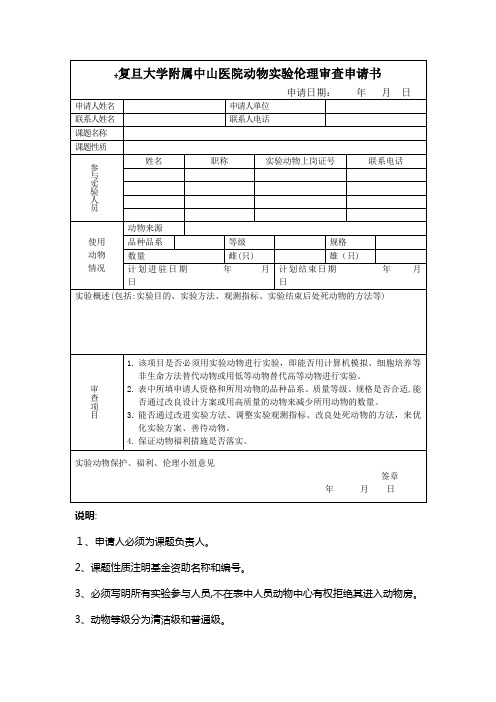
说明:1、申请人必须为课题负责人。
2、课题性质注明基金资助名称和编号。
3、必须写明所有实验参与人员,不在表中人员动物中心有权拒绝其进入动物房。
3、动物等级分为清洁级和普通级。
4、动物规格以周龄或体重计,周龄上下浮动1周,体重上下浮动5%.说明:1、有毒有害器材、试剂包括生物制品(如天然或基因修饰病原体,活载体,细胞, 血清等),放射性物质,腐蚀性物质,致癌性物质,易燃易爆化学品等,以及包含上述物质的器材.2、申请人必须为课题负责人。
3、课题性质注明基金资助名称和编号.4、必须写明所有实验参与人员,不在表中人员动物中心有权拒绝其进入动物房。
5、注明实验人员是否经过相应的有毒有害器材、试剂使用培训及时间.说明:1、课题负责人为经费提供者。
2、课题性质注明基金资助名称和编号。
3、必须写明所有实验参与人员,不在表中人员动物中心有权拒绝其进入动物房。
4、动物等级分为清洁级和普通级。
动物规格以周龄或体重计,周龄上下浮动1周,体重上下浮动5%。
5、饲养设施分为开放系统,要求动物为普通级;IVC和屏障系统,要求动物为清洁级.6、根据大鼠每笼最多5只,小鼠每笼最多15只,豚鼠每笼最多3只,兔和犬每笼1只及实验分组情况计算所需笼数。
7、有毒有害器材、试剂包括生物制品(如天然或基因修饰病原体,活载体,细胞, 血清等),放射性物质,腐蚀性物质,致癌性物质,易燃易爆化学品等,以及包含上述物质的器材.8、付费方式为银行转帐,院内转帐或现金。
说明:1、申请人可为参与实验人员,课题负责人为经费提供者。
2、课题性质注明基金资助名称和编号。
3、动物等级分为清洁级和普通级。
4、动物规格以周龄或体重计,周龄上下浮动1周,体重上下浮动5%。
5、预计总费用应包含动物包装费和运输费.通常每个可装15只小鼠的包装箱15元,可装20只大鼠的包装箱45元,每次运输费30元。
此项费用在动物实验费用结算时多退少补。
6、进驻日期为实验人员希望动物进入中心的日期,至少在申请日期前一周。
美国仿制药申报常见缺陷解读

美国仿制药申报常见缺陷解读(一):组成和辅料部分发布者:国际药用辅料网发表时间:2014/9/15 13:27:24美国仿制药申报简称为ANDA申报。
对于意图进入美国医药市场的中国企业,这是一个相对方便快捷的途径。
Atoka Srinivasan 和Robert Iser发表了,介绍了美国仿制药申报的常见缺陷。
在得到原作者书面授权后,笔者进行了翻译和适当的解读。
美国ANDA审评中出现在描述、组成和辅料部分的案例1.制剂中成份和组成表不完整,请修订申请者的成份和组成表以包括制剂的每种规格的所有成份的百分比。
2.在处方中盐酸或氢氧化钠的功能已规定表示为缓冲剂。
请详加阐述,因为这两个试剂通常不作为缓冲剂。
必要时,提供更新的成份和组成表。
3.请通过论证参比药物(RLD)有相似或更高的过量投料来证实你们处方中的过量投料的合理性。
我们建议与多批RLD对比来证实所推荐的过量投料量。
4.我们注意到申请人所推荐的处方与RLD有明显差别,我们要求你们做进一步的解释,以说明为什么这些差异不会影响你们制剂标签所声明的性能和既定用途。
5.我们要指出辅料相容性研究的前提是确保原辅料间无不良的化学反应,因此,我们要求在你们以后的申请中,在药物开发中,要研究化学变化而不是仅研究物理变化。
6.请提供计算证明铁元素的量符合21CFR 73.1200中的推荐值,该值根据建议的产品最大日剂量来计算。
7.请证明你们的缓释制剂中释放控制(辅料名称)相关特性的功能合理性,比如:粘度范围。
请叙述范围的最低点和最高点对制剂的关键质量属性(如释放分布情况)有何影响。
8.由于原料药有羧基存在,可能与处方中甘油有潜在的相互作用。
请证实推荐采用的分析方法是适合于鉴别和定量任何可能形成的酯类产品。
9.有文献报道在制药生产工艺条件和产品有效期内乳糖与伯胺反应形成加合物“Amadori”(Maillard反应),既然你们的原料药是胺类且乳糖是主要辅料,而你们的药物开发报告并未对此进行研究。
美国专利申请法律状态查询数据库的使用
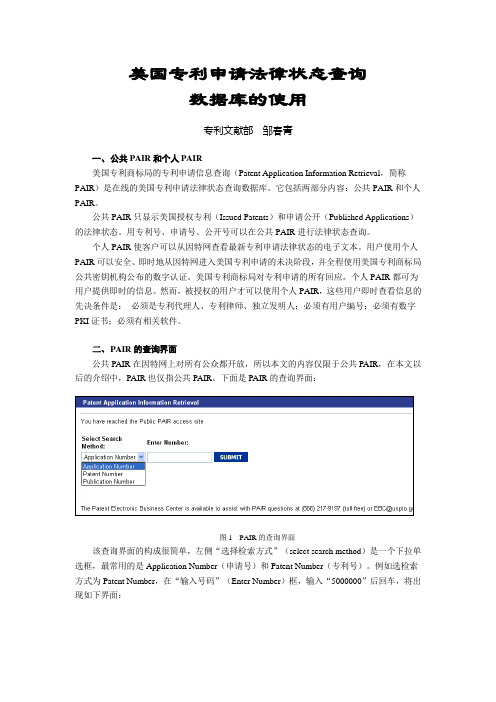
美国专利申请法律状态查询数据库的使用专利文献部邹春青一、公共PAIR和个人PAIR美国专利商标局的专利申请信息查询(Patent Application Information Retrieval,简称PAIR)是在线的美国专利申请法律状态查询数据库。
它包括两部分内容:公共PAIR和个人PAIR。
公共PAIR只显示美国授权专利(Issued Patents)和申请公开(Published Applications)的法律状态。
用专利号、申请号、公开号可以在公共PAIR进行法律状态查询。
个人PAIR使客户可以从因特网查看最新专利申请法律状态的电子文本。
用户使用个人PAIR可以安全、即时地从因特网进入美国专利申请的未决阶段,并全程使用美国专利商标局公共密钥机构公布的数字认证。
美国专利商标局对专利申请的所有回应,个人PAIR都可为用户提供即时的信息。
然而,被授权的用户才可以使用个人PAIR,这些用户即时查看信息的先决条件是:必须是专利代理人、专利律师、独立发明人;必须有用户编号;必须有数字PKI证书;必须有相关软件。
二、P AIR的查询界面公共PAIR在因特网上对所有公众都开放,所以本文的内容仅限于公共PAIR,在本文以后的介绍中,PAIR也仅指公共PAIR。
下面是PAIR的查询界面:图1 PAIR的查询界面该查询界面的构成很简单,左侧“选择检索方式”(select search method)是一个下拉单选框,最常用的是Application Number(申请号)和Patent Number(专利号)。
例如选检索方式为Patent Number,在“输入号码”(Enter Number)框,输入“5000000”后回车,将出现如下界面:图2 申请数据三、“申请数据”实际上,PAIR共有6-7个可供打开的选项,默认打开的是“申请数据”(application data),该选项内容如下:∙Application Number: 申请号∙Filing or 371(c) Date: 申请或371 (c)日期∙Application Type: 申请种类∙Examiner Name: 审查员姓名∙Group Art Unit: 技术组∙Confirmation Number: 批准号∙Attorney Docket Number: 律师签号∙Class / Sub-Class: 类/小类号∙First Named Inventor:第一发明人姓名∙Title of Invention: 发明名称∙Customer Number: 客户名∙Status:法律状态∙Status Date: 法律状态日期∙Location: 表明正式文件目前的存放地点∙Location Date: 存放日期∙Earliest Publication No: 最早公开号∙Earliest Publication Date: 最早公开日期∙Patent Number: 专利号∙Issue Date of Patent: 专利授权日期除以上“申请数据”选项外,本文着重介绍“继续申请数据”(Continuity Data)和“费用”(fees)这两个最常用的选项。
弱电系统 dimming 控制器说明书
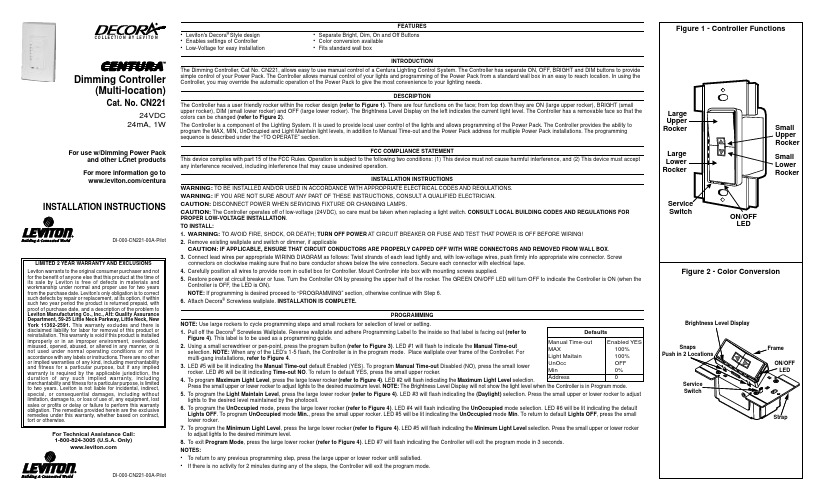
FEATURES•Leviton's Decora ® Style design •Separate Bright, Dim, On and Off Buttons •Enables settings of Controller •Color conversion available •Low-Voltage for easy installation•Fits standard wall boxINTRODUCTIONThe Dimming Controller, Cat No. CN221, allows easy to use manual control of a Centura Lighting Control System. The Controller has separate ON, OFF, BRIGHT and DIM buttons to provide simple control of your Power Pack. The Controller allows manual control of your lights and programming of the Power Pack from a standard wall box in an easy to reach location. In using the Controller, you may override the automatic operation of the Power Pack to give the most convenience to your lighting needs.DESCRIPTIONThe Controller has a user friendly rocker within the rocker design (refer to Figure 1). There are four functions on the face; from top down they are ON (large upper rocker), BRIGHT (small upper rocker), DIM (small lower rocker) and OFF (large lower rocker). The Brightness Level Display on the left indicates the current light level. The Controller has a removable face so that the colors can be changed (refer to Figure 2).The Controller is a component of the Lighting System. It is used to provide local user control of the lights and allows programming of the Power Pack. The Controller provides the ability to program the MAX, MIN, UnOccupied and Light Maintain light levels, in addition to Manual Time-out and the Power Pack address for multiple Power Pack installations. The programming sequence is described under the “TO OPERATE” section.FCC COMPLIANCE STATEMENTThis device complies with part 15 of the FCC Rules. Operation is subject to the following two conditions: (1) This device must not cause harmful interference, and (2) This device must accept any interference received, including interference that may cause undesired operation.INSTALLATION INSTRUCTIONSWARNING: TO BE INSTALLED AND/OR USED IN ACCORDANCE WITH APPROPRIATE ELECTRICAL CODES AND REGULATIONS.WARNING: IF YOU ARE NOT SURE ABOUT ANY PART OF THESE INSTRUCTIONS, CONSULT A QUALIFIED ELECTRICIAN.CAUTION: DISCONNECT POWER WHEN SERVICING FIXTURE OR CHANGING LAMPS.CAUTION: The Controller operates off of low-voltage (24VDC), so care must be taken when replacing a light switch. CONSULT LOCAL BUILDING CODES AND REGULATIONS FORPROPER LOW-VOLTAGE INSTALLATION .TO INSTALL:1.WARNING: TO AVOID FIRE, SHOCK, OR DEATH; TURN OFF POWER AT CIRCUIT BREAKER OR FUSE AND TEST THAT POWER IS OFF BEFORE WIRING!2.Remove existing wallplate and switch or dimmer, if applicableCAUTION: IF APPLICABLE, ENSURE THAT CIRCUIT CONDUCTORS ARE PROPERLY CAPPED OFF WITH WIRE CONNECTORS AND REMOVED FROM WALL BOX .3.Connect lead wires per appropriate WIRING DIAGRAM as follows: Twist strands of each lead tightly and, with low-voltage wires, push firmly into appropriate wire connector. Screw connectors on clockwise making sure that no bare conductor shows below the wire connectors. Secure each connector with electrical tape.4.Carefully position all wires to provide room in outlet box for Controller. Mount Controller into box with mounting screws supplied.5.Restore power at circuit breaker or fuse. Turn the Controller ON by pressing the upper half of the rocker. The GREEN ON/OFF LED will turn OFF to indicate the Controller is ON (when the Controller is OFF, the LED is ON).NOTE: If programming is desired proceed to “PROGRAMMING” section, otherwise continue with Step 6.6.Attach Decora ® Screwless wallplate. INSTALLATION IS COMPLETE.PROGRAMMINGNOTE: Use large rockers to cycle programming steps and small rockers for selection of level or setting.1.Pull off the Decora ® Screwless Wallplate. Reverse wallplate and adhere Programming Label to the inside so that label is facing out (refer to Figure 4). This label is to be used as a programming guide.ing a small screwdriver or pen-point, press the program button (refer to Figure 3). LED #1 will flash to indicate the Manual Time-outselection. NOTE: When any of the LED’s 1-5 flash, the Controller is in the program mode. Place wallplate over frame of the Controller. Formulti-gang installations, refer to Figure 4.3.LED #5 will be lit indicating the Manual Time-out default Enabled (YES). To program Manual Time-out Disabled (NO), press the small lowerrocker. LED #6 will be lit indicating Time-out NO . To return to default YES, press the small upper rocker.4.To program Maximum Light Level , press the large lower rocker (refer to Figure 4). LED #2 will flash indicating the Maximum Light Level selection.Press the small upper or lower rocker to adjust lights to the desired maximum level. NOTE: The Brightness Level Display will not show the light level when the Controller is in Program mode.5.To program the Light Maintain Level , press the large lower rocker (refer to Figure 4). LED #3 will flash indicating the (Daylight) selection. Press the small upper or lower rocker to adjust lights to the desired level maintained by the photocell.6.To program the UnOccupied mode, press the large lower rocker (refer to Figure 4). LED #4 will flash indicating the UnOccupied mode selection. LED #6 will be lit indicating the default Lights OFF . To program UnOccupied mode Min., press the small upper rocker. LED #5 will be lit indicating the UnOccupied mode Min . To return to default Lights OFF , press the small lower rocker.7.To program the Minimum Light Level , press the large lower rocker (refer to Figure 4). LED #5 will flash indicating the Minimum Light Level selection. Press the small upper or lower rocker to adjust lights to the desired minimum level.8.To exit Program Mode , press the large lower rocker (refer to Figure 4). LED #7 will flash indicating the Controller will exit the program mode in 3 seconds.NOTES:•To return to any previous programming step, press the large upper or lower rocker until satisfied.•If there is no activity for 2 minutes during any of the steps, the Controller will exit the program mode.For Technical Assistance Call:1-800-824-3005 (U.S.A. Only)LIMITED 2 YEAR WARRANTY AND EXCLUSIONS Leviton warrants to the original consumer purchaser and not for the benefit of anyone else that this product at the time of its sale by Leviton is free of defects in materials and workmanship under normal and proper use for two years from the purchase date. Leviton’s only obligation is to correct such defects by repair or replacement, at its option, if within such two year period the product is returned prepaid, with proof of purchase date, and a description of the problem to Leviton Manufacturing Co., Inc., Att: Quality Assurance Department, 59-25 Little Neck Parkway, Little Neck, New York 11362-2591. This warranty excludes and there is disclaimed liability for labor for removal of this product or reinstallation. This warranty is void if this product is installed improperly or in an improper environment, overloaded,misused, opened, abused, or altered in any manner, or is not used under normal operating conditions or not in accordance with any labels or instructions. There are no other or implied warranties of any kind, including merchantability and fitness for a particular purpose, but if any implied warranty is required by the applicable jurisdiction, the duration of any such implied warranty, including merchantability and fitness for a particular purpose, is limited to two years. Leviton is not liable for incidental, indirect,special, or consequential damages, including without limitation, damage to, or loss of use of, any equipment, lost sales or profits or delay or failure to perform this warranty obligation. The remedies provided herein are the exclusive remedies under this warranty, whether based on contract,tort or otherwise.DI-000-CN221-00A-PilotC O L L E C T I O N B Y L E V I T O NDimming Controller(Multi-location)Cat. No. CN22124VDC 24mA, 1WFor use w/Dimming Power Packand other LCnet productsFor more information go to /centuraINSTALLATION INSTRUCTIONSDI-000-CN221-00A-PilotDefaults Manual Time-out Enabled YESMAX 100%Light Maitain 100%UnOcc OFF Min 0%Address 0D I -000-C N 221-00A -P i l o tTO OPERATE:ON:Press the upper half of the large rocker. The lights will fade ON.OFF:Press the lower half of the large rocker. The lights will fade to OFF (ON/OFF LED lit).BRIGHTEN:Press and hold the upper half of the small rocker to the desired light level.FULL BRIGHT:If the lights ON, pressing the upper half of the large rocker will turn lights ON to the maximum level.DIM:sPress and hold the lower half of the small rocker to the desired level.SERVICE SWITCH: On the lower left corner of the switch plate, there is a Service Switch (refer to Figure 1). When servicing a controlled fixture, pull lever out (OFFposition). This will send a message to the Power Pack to keep the lights OFF. After servicing is complete, push the lever in (ON position) to restore power. The lever must be pushed in all the way (ON position) for normal operation.BRIGHTNESS LEVEL DISPLAY: Indicates the level of brightness when the lights are ON. Indicates the previous level of brightness when the lights are OFF (refer to Figure 2). When lights are OFF, the brightness level of lights can be changed before turning lights ON by pressing the small rocker UP/DOWN.COMMUNICATION LED: The communication LED will flash when the Controller transmits a message, and when it receives a valid message. It is located under the wallplate (under the screwless wallplate adapter, not shown) (refer to Figure 3). It is visible in the space between the frame and the wallplate adapter.LIGHT LEVELS:MAX: The maximum light level is adjustable between 60%-100%.MIN: The minimum light level is adjustable between 0%-40%.UnOccupied: The UnOccupied level is the selection between OFF and MIN. Therefore, when the occupancy sensor detects an absence of motion, the lights will be either OFF or at MIN, depending on the setting.Light Maintain: The Light Maintain level is the amount of light that the Power Pack will maintain in the room. The Power Pack maintains a programmed light level by adjusting the lights automatically to compensate for the ambient light present in the room. If the room is very bright (mid-day), the lights will be set to a dim level. If the room is dark (evening and morning), the lights will be set to a bright level. This desired level of light is programmed by the Controller.MANUAL TIME-OUT:The Power Pack adjusts the lights in order to automatically maintain a programmed light level (as described above). There are times when this light level needs to be manually overridden. However, some local building codes (such as California Title 24) do not allow lights to be permanently raised above the Light Maintain level. The time-out is 30 minutes.NOTE: The time-out can be disabled for installations that do not need to conform to these building codes. The Manual Time-out is a selection between enable (Time YES) and disable (Time NO).Power Pack ADDRESS:The Controller and the Power Pack must have the same address in order to communicate to each other. The default address is the same, but when installing multiple Power Packs,each must have a different address.The Controller has an address wheel for addressing (refer to Figure 3). If there is only one Power Pack on the bus, the address wheel DOES NOT have to be adjusted. For installations where there are multiple Power Packs, the raddress wheel is used to set the Power Pack ’s address (refer to the Dimming Power Pack’s Instruction Sheet for further details).To set the Power Pack ’s address, proceed as follows:1.Remove wallplate and the frame (may have to remove screwless wallplate adapter also).ing a small screwdriver, rotate the address wheel to the next unused address.3.Pull out Service Switch.4.Press the Address Selection button on the Power Pack.5.Return Service Switch to the IN position.6.Address is now selected.NOTE: Only one Power Pack can be programmed at a time.MULTI-LOCATION :Up to 4 Controllers can be connected in parallel. All Controllers MUST be on the same address.COLOR CONVERSION PROCEDUREThe color of this device can be changed to suit your interior design requirements. Simply obtain a color conversion kit of the appropriate color from your Leviton distributor and proceed as follows (please note that wallplate must be removed).1.Select the color of the face you desire.2.The frame has snaps on its sides. Using a small screwdriver, gently remove the frame from the strap (refer to Figure 2).3.Take the new frame and position it properly to the strap. Notice that the frame has a cut-out for the safety switch lever. Line up the plastic snaps with the square holes in the strap. Insert the snaps on one side of the frame into the strap.4.Firmly press sideways and down to slip the other snaps into place. The frame snaps in with a audible click. Ensure that all four snaps are secure. Replace Decora ®wallplate. The color conversion is complete.TROUBLESHOOTING•If NO LED ’s are lit; there is no power - Check wiring.•If none of the Brightness Level Display LED ’s are lit, but OFF LED is lit; there is no communication to the Power Pack - check communication wiring.- check that Power Pack is operating.•Communication LED does NOT light when the button is pressed - Check power wiring connections.For Multiple Power Packs on the Bus:•The Controller has power (at least the OFF led is ON) but pressing the buttons have no effect on the lights; there is no communication between the Controller and the Power Pack- If the communication LED does NOT flash when a button is pressed, see above.- If the communication LED does flash, check the address of the Power Pack and Controller (refer to Dimming Power Pack Instructions).。
实验室_OOS_OOE_OOT

4
关键术语解释
实验室偏差: 指由于任何与检验过程相关的因素所引起的检验结果偏差。包 括取样、样品容器、存放条件、检验操作、计算过程、使用 试剂、仪器等问题引起的偏差。 非实验室偏差: 指在排除实验室偏差以外的由于其它任何因素所引起的检验结 果偏差。
5
背景
案例: FDA与BARR实验室(美国基因公司) 起因于1993年 BARR公司与FDA之间就对于实验失败的结 果未达一致, FDA指控该公司的实验室,QA和验证部门玩 忽职守。指控包括以下内容 采用未经验证的工艺; 未受控制的试验 多批次的失败 通过试验批次修订标准 通过新泽西地区法院Wolin法官裁决指出造成OOS/OOE的 原因: 相关工艺发生错误:如非粗放的工艺 非相关工艺发生错误:如操作工失误,设备故障,供应商 错误,取样问题。
12
实验室调查阶段
如适当实验室以外人员也可包含在审核中, 审核应文件化并 被批准。 如果调查表明OOS或非典型性结果为实验室错误则应记 录结论并经批准,重复分析,适当的时候OOS可被纠正而不 通过复验如:计算错误。 如果实验规程中包含了配制样品的使用,重复分析时 可用最初分析时配制的样品,但要求是样品配制正确,复验 期间是稳定的;当样品不稳定或其稳定性不确定时,应从实 验室样品中重取一部分进行重复分析
14
扩大范围调查阶段
如果实验室调查研究表明结果是有效的,或调查研究是不确 定的,则展开扩大调查研究以确定OOS/OOE结果可能的原因 和它的影响。通常包括实验室以外的部门,如:生产,质量 保证,质量规范执行,供应商。 扩大范围调查包括下列行为: 信息审核: 制造工艺 试验物料或产品历史 中控试验 其他试验项目结果 物料或产品实验的前史 供应商信息CoA
FDA清洗验证检查指南
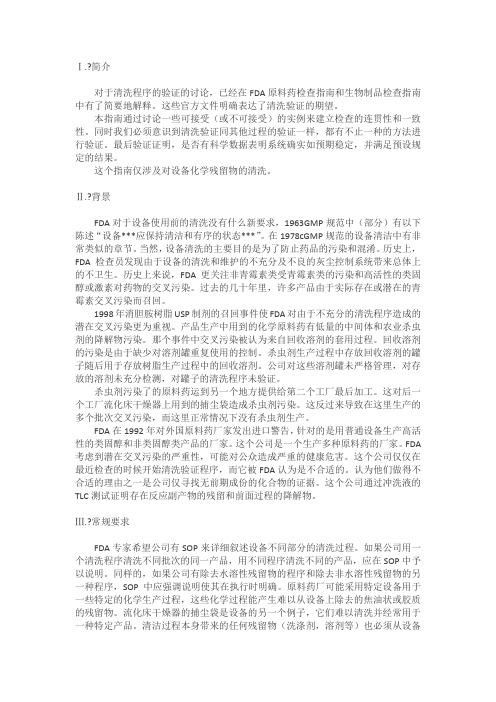
对于清洗程序的验证的讨论,已经在FDA原料药检查指南和生物制品检查指南中有了简要地解释。
这些官方文件明确表达了清洗验证的期望。
本指南通过讨论一些可接受(或不可接受)的实例来建立检查的连贯性和一致性。
同时我们必须意识到清洗验证同其他过程的验证一样,都有不止一种的方法进行验证。
最后验证证明,是否有科学数据表明系统确实如预期稳定,并满足预设规定的结果。
这个指南仅涉及对设备化学残留物的清洗。
Ⅱ.?背景FDA对于设备使用前的清洗没有什么新要求,1963GMP规范中(部分)有以下陈述“设备***应保持清洁和有序的状态***”。
在1978cGMP规范的设备清洁中有非常类似的章节。
当然,设备清洗的主要目的是为了防止药品的污染和混淆。
历史上,FDA检查员发现由于设备的清洗和维护的不充分及不良的灰尘控制系统带来总体上的不卫生。
历史上来说,FDA更关注非青霉素类受青霉素类的污染和高活性的类固醇或激素对药物的交叉污染。
过去的几十年里,许多产品由于实际存在或潜在的青霉素交叉污染而召回。
1998年消胆胺树脂USP制剂的召回事件使FDA对由于不充分的清洗程序造成的潜在交叉污染更为重视。
产品生产中用到的化学原料药有低量的中间体和农业杀虫剂的降解物污染。
那个事件中交叉污染被认为来自回收溶剂的套用过程。
回收溶剂的污染是由于缺少对溶剂罐重复使用的控制。
杀虫剂生产过程中存放回收溶剂的罐子随后用于存放树脂生产过程中的回收溶剂。
公司对这些溶剂罐未严格管理,对存放的溶剂未充分检测,对罐子的清洗程序未验证。
杀虫剂污染了的原料药运到另一个地方提供给第二个工厂最后加工。
这对后一个工厂流化床干燥器上用到的捕尘袋造成杀虫剂污染。
这反过来导致在这里生产的多个批次交叉污染,而这里正常情况下没有杀虫剂生产。
FDA在1992年对外国原料药厂家发出进口警告,针对的是用普通设备生产高活性的类固醇和非类固醇类产品的厂家。
这个公司是一个生产多种原料药的厂家。
FDA 考虑到潜在交叉污染的严重性,可能对公众造成严重的健康危害。
Q5D细胞库--中英文对照

Tel. (44-20) 74 18 85 75 Fax (44-20) 75 23 70 40
E-mail: mail@emea.eu.int http://www.emea.eu.int
EMEA 2006 Reproduction and/or distribution of this document is authorised for non commercial purposes only provided the EMEA is acknowledged
Information obtained directly from the source laboratory is preferred. When this is not available, literature references may be utilised.
For human cell lines, it is relevant to describe the following characteristics of the original donor: Tissue or organ of origin, ethnic and geographical origin, age, sex and general physiological condition. If known, the state of health or medical history of the donor should be reported along with the results of any tests of the donor for pathogenic agents. Specifically for human diploid fibroblasts, the age of the donor may influence the in vitro lifespan of the cell line and this information should be provided if available. For animal cell lines, relevant descriptions of the source include species, strains, breeding conditions, tissue or organ of origin, geographical origin, age and sex, the results of tests for pathogenic agents, and general physiological condition of the original donor.
FDA认证检查的六大系统
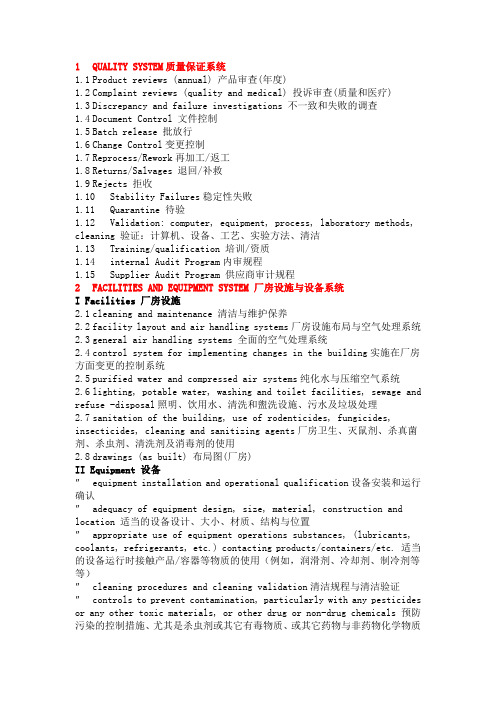
1 QUALITY SYSTEM质量保证系统1.1 Product reviews (annual) 产品审查(年度)1.2 Complaint reviews (quality and medical) 投诉审查(质量和医疗)1.3 Discrepancy and failure investigations 不一致和失败的调查1.4 Document Control 文件控制1.5 Batch release 批放行1.6 Change Control变更控制1.7 Reprocess/Rework再加工/返工1.8 Returns/Salvages 退回/补救1.9 Rejects 拒收1.10 Stability Failures稳定性失败1.11 Quarantine 待验1.12 Validation: computer, equipment, process, laboratory methods, cleaning 验证:计算机、设备、工艺、实验方法、清洁1.13 Training/qualification 培训/资质1.14 internal Audit Program内审规程1.15 Supplier Audit Program 供应商审计规程2 FACILITIES AND EQUIPMENT SYSTEM 厂房设施与设备系统I Facilities 厂房设施2.1 cleaning and maintenance 清洁与维护保养2.2 facility layout and air handling systems厂房设施布局与空气处理系统2.3 general air handling systems 全面的空气处理系统2.4 control system for implementing changes in the building实施在厂房方面变更的控制系统2.5 purified water and compressed air systems纯化水与压缩空气系统2.6 lighting, potable water, washing and toilet facilities, sewage and refuse -disposal照明、饮用水、清洗和盥洗设施、污水及垃圾处理2.7 sanitation of the building, use of rodenticides, fungicides, insecticides, cleaning and sanitizing agents厂房卫生、灭鼠剂、杀真菌剂、杀虫剂、清洗剂及消毒剂的使用2.8 drawings (as built) 布局图(厂房)II Equipment 设备"equipment installation and operational qualification设备安装和运行确认"adequacy of equipment design, size, material, construction and location 适当的设备设计、大小、材质、结构与位置"appropriate use of equipment operations substances, (lubricants, coolants, refrigerants, etc.) contacting products/containers/etc. 适当的设备运行时接触产品/容器等物质的使用(例如,润滑剂、冷却剂、制冷剂等等)"cleaning procedures and cleaning validation清洁规程与清洁验证"controls to prevent contamination, particularly with any pesticides or any other toxic materials, or other drug or non-drug chemicals 预防污染的控制措施、尤其是杀虫剂或其它有毒物质、或其它药物与非药物化学物质"qualification, calibration and maintenance of refrigerators and freezers 电冰箱和冷冻机的确认、校验和维护保养"equipment qualification, calibration and maintenance, including computer qualification/validation and security 设备确认、校准与维护保养,包括计算机确认/验证和安全"control system for implementing changes in the equipment实施在设备方面发生的变更的控制系统"equipment identification practices (where appropriate) 设备验收(如适用)"documented investigation into any unexpected discrepancy记录对任何未期望的不一致的调查3 MATERIALS SYSTEM物料系统3.1 training/qualification of personnel人员的培训/资质3.2 identification of components, containers, closures组分、容器密封件的鉴定3.3 inventory of components, containers, closures组分、容器密封件的目录3.4 storage conditions贮存条件3.5 storage under quarantine在隔离下的贮存3.6 representative samples collected, tested or examined using appropriate means 用适当的方法收集、检验和检查有代表性样品3.7 at least one specific identity test is conducted on each lot of each component每个组分每一批,至少做一个专属性实验3.8 a visual identification is conducted on each lot of containers and closures每批容器和密封件,应做一个目测确认3.9 testing or validation of supplier's test results for components, containers and closures对供应商的组分、容器和密封件的化验结果的检验或验证3.10 rejection of any component, container, closure not meeting acceptance requirements不符合可接受要求的组分、容器和密封件的拒收3.11 appropriate retesting/reexamination of components, containers, closures 组分、容器和密封件适当的复验/复查3.12 first in-first out use of components, containers, closures 组分、容器和密封件的先入先出3.13 quarantine of rejected materials 拒收物料的隔离3.14 water and process gas supply, design, maintenance, validation and operation 水与工艺用气的供应、设计、维护保养、验证和操作3.15 control system for implementing changes in the materials handling operations 实施在物料处理操作方面所发生的变更的控制系统3.16 qualification/validation and security of computerized or automated processes 计算机化或自动化过程的确认/验证和安全3.17 finished product distribution records by lot 最终产品按批的销售记录3.18 documented investigation into any unexpected discrepancy记录任何未期望的不一致的调查4 PRODUCTION SYSTEM生产系统4.1 training/qualification of personnel人员的培训/资质4.2 control system for implementing changes in processes实施在工艺方面所发生的变更的控制系统4.3 adequate procedure and practice for charge-in of components对于控制组分的适当的规程和操作4.4 identification of equipment with contents, and where appropriate phase of manufacturing and/or status 装有内容物的设备的标注,以及适当的生产阶段和/或状态4.5 calculation and documentation of actual yields and percentage of theoretical yields 实际产率和理论产率百分数的计算与记录4.6 complete batch production documentation全部的批生产记录4.7 established time limits for completion of phases of production 针对生产阶段完成而制订的时间限度4.8 implementation and documentation of in-process controls, tests, and examinations (e.g., pH, adequacy of mix, weight variation, clarity)过程控制、检测和检查(例如pH、混合的充分、重量差异和透明度)的实施与记录4.9 Justification and consistency of in-process specification and drug product final specifications 中间体的质量标准和成品的质量标准的合理性及其一致性4.10 final specifications 最终的质量标准4.11 prevention of objectionable microorganisms in non-sterile drug products 在非无菌产品中,有害微生物的预防4.12 pre-processing procedures (e.g., set-up, line clearance, etc.) 前处理规程(例如安装,清场等)4.13 equipment cleaning and use logs 设备清洁与使用日志4.14 master production and control records主要生产与控制记录(工艺规程)4.15 batch production and control records批生产与控制记录4.16 process validation, including validation and security of computerized or automated processes 工艺验证:包括计算机化和自动化工艺的验证和安全4.17 change control变更控制4.18 documented investigation into any unexpected discrepancy记录任何未期望的不一致的调查5 PACKAGING AND LABELING SYSTEM包装与标示系统5.1 training/qualification of personnel人员的培训/资质5.2 acceptance operations for packaging and labeling materials适当的包装和标示材料的操作5.3 control system for implementing changes in packaging and labeling operations实施在包装和标示操作方面所发生的变更的控制系统5.4 adequate storage for labels and labeling, both approved and returned after issued 标签和标示适当的贮存,包括已批准的和分发后退回的5.5 control of labels which are similar in size, shape, and color for different products对于不同的产品,标签在大小、形状和颜色相似方面的控制5.6 label verification system标签确认系统5.7 is gang printing used?使用大批量的印刷吗?5.8 adequate packaging records that will include specimens of all labels used 适当的包装记录,它应包括所有所用的标签的种类5.9 control of issuance of labeling, examination of issued labels and reconciliation of used labels标示分发的控制,被分发的标签和被使用的标签的物料衡算5.10 examination of the labeled finished product被标示的最终产品的检查5.11 adequate inspection (proofing) of incoming labeling进厂标示的适当的检查(校对)5.12 use of lot numbers, destruction of excess labeling bearinglot/control numbers 批号的使用,多余的带有批号/控制号标示的销毁5.13 physical separation between different labeling and packaging lines在不同标示和包装线之间的物理的分隔5.14 monitoring of printing devices associated with manufacturing lines与生产线相关的打印装置的监测5.15 line clearance, inspection and documentation生产线的清洁、检查和记录5.16 adequate expiration dates on the label关于标签的适当的有效期5.17 validation of packaging and labeling operations包装和标示操作的验证5.18 documented investigation into any unexpected discrepancy记录任何任何未期望的不一致的调查6 LABORATORY CONTROL SYSTEM实验室控制系统6.1 training/qualification of personnel人员的培训/资质6.2 adequacy of staffing for laboratory operations足够的实验室操作人员6.3 adequacy of equipment and facility for intended use适当的设备与设施6.4 calibration and maintenance programs for analytical instruments and equipment分析仪器和设备的校准与维护保养6.5 validation and security of computerized or automated processes计算机化或自动化过程的验证和安全6.6 reference standards; source, purity and assay, and tests to establish equivalency to current official reference standards as appropriate对照标准品:来源、纯度和含量、以及为建立与目前官方的对照标准品等效所做的检测项目6.7system suitability checks on chromatographic systems (e.g., GC or HPLC) 有关色谱系统(例如气相或高压液相)的系统适用性检查6.8 specifications, standards, and representative sampling plans质量标准、标准品和有代表性的取样计划6.9 adherence to the written methods of analysis遵循书面的分析方法6.10 validation/verification of analytical methods分析方法的验证/确认6.11 control system for implementing changes in laboratory operations 实施在实验室操作方面所发生的变更的控制系统6.12 Required testing is performed on the correct samples对于正确的样品,执行所要求的检验6.13 documented investigation into any unexpected discrepancy 记录任何未期望的不一致的调查6.14 complete analytical records from all tests and summaries of results来自所有检验的完整的分析记录和结果的总结6.15 quality and retention of raw data (e.g., chromatograms and spectra)原始数据的质量和保存(例如色谱图和光谱图)6.16 correlation of result summaries to raw data; presence of unused data结果总结与原始数据的相关性,未使用的数据的存在6.17 adherence to an adequate Out of Specification (OOS) procedure which includes timely completion of the investigation遵循一个适当的OOS 的规程,此规程包括调查的及时完成6.18 adequate reserve samples; documentation of reserve sample examination足够的留样、留样检查的文件6.19 stability testing program, including demonstration of stability indicating capability of the test methods稳定性检测的规程,包括检测方法的显示稳定性的证明。
新药I期临床试验申请技术指南(草案)160930

新药I 期临床试验申请技术指南(草案)国家食品药品监督管理总局(CFDA)2016年9月1目录一、前言 (1)二、背景 (2)三、与药审中心沟通交流 (3)四、IND提交所需的特定信息 (4)(一)规定的表格 (4)(二)文件目录 (5)(三)介绍性说明和总体研究计划 (5)(四)研究者手册 (6)(五)方案 (8)(六)化学、生产和控制信息 (9)(七)药理毒理信息 (14)(八)研究药物既往在人体使用的经验 (16)(九)其他重要信息 (17)(十)相关信息 (17)五、提交信息 (17)六、IND过程和审评过程 (18)(一)临床试验暂停要求 (19)(二)IND修订 (21)1七、申请人的其他责任 (22)(一)遵守法规伦理要求 (22)(二)监测正在进行的研究 (22)(三)研究药物的推销或付费 (23)(四)记录和报告 (23)(五)IND安全性报告 (23)(六)IND年度报告 (24)八、撤回、终止、暂停或者重新启动IND (25)附件 (26)附件1:药品注册临床试验申报资料信息表 (26)附件2:研究者声明表 (29)附件3: 化药Ⅰ期临床研究CMC资料表 (32)2新药I期临床试验申请技术指南一、前言国家食品药品监督管理总局(CFDA)发布本技术指南旨在帮助新药研发申请人提交足够的临床试验研究申请(Investigational new drug,IND)材料,以提高新药研发与审评效率,并同时能保证药品的安全性、有效性和质量可控性。
本指导原则阐述了在中国将研究药品(包括已进行结构确证的治疗性生物工程类产品)开始用于人体研究时,所需要提供的数据。
将申报资料的要求按照新药不同的研究阶段加以分类,在满足向CFDA提供评估拟进行研究所需要数据的同时,建立对同一类别IND申报的统一标准,增加IND申报要求的透明度、标准化,减少模糊性和不一致性,将有助于缩短新药批准进入临床试验的时间。
验证文件汇总
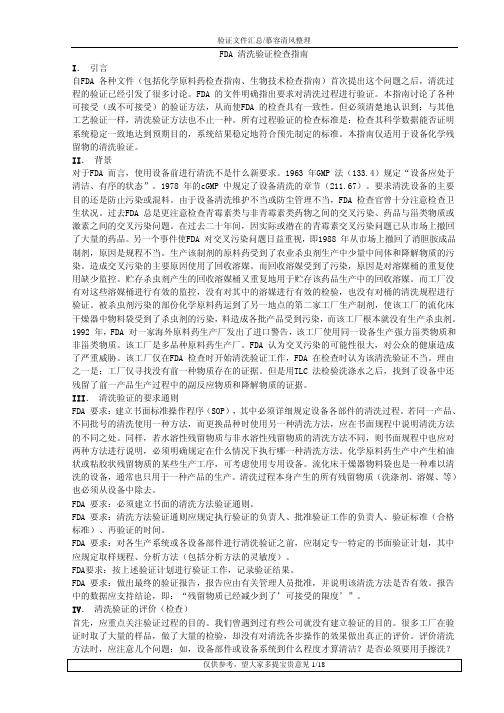
FDA 清洗验证检查指南I. 引言自FDA 各种文件(包括化学原料药检查指南、生物技术检查指南)首次提出这个问题之后,清洗过程的验证已经引发了很多讨论。
FDA 的文件明确指出要求对清洗过程进行验证。
本指南讨论了各种可接受(或不可接受)的验证方法,从而使FDA 的检查具有一致性。
但必须清楚地认识到:与其他工艺验证一样,清洗验证方法也不止一种。
所有过程验证的检查标准是:检查其科学数据能否证明系统稳定一致地达到预期目的,系统结果稳定地符合预先制定的标准。
本指南仅适用于设备化学残留物的清洗验证。
II. 背景对于FDA 而言,使用设备前进行清洗不是什么新要求。
1963 年GMP 法(133.4)规定“设备应处于清洁、有序的状态”。
1978 年的cGMP 中规定了设备清洗的章节(211.67)。
要求清洗设备的主要目的还是防止污染或混料。
由于设备清洗维护不当或防尘管理不当,FDA 检查官曾十分注意检查卫生状况。
过去FDA 总是更注意检查青霉素类与非青霉素类药物之间的交叉污染、药品与甾类物质或激素之间的交叉污染问题。
在过去二十年间,因实际或潜在的青霉素交叉污染问题已从市场上撤回了大量的药品。
另一个事件使FDA 对交叉污染问题日益重视,即1988 年从市场上撤回了消胆胺成品制剂,原因是规程不当。
生产该制剂的原料药受到了农业杀虫剂生产中少量中间体和降解物质的污染。
造成交叉污染的主要原因使用了回收溶媒。
而回收溶媒受到了污染,原因是对溶媒桶的重复使用缺少监控。
贮存杀虫剂产生的回收溶媒桶又重复地用于贮存该药品生产中的回收溶媒。
而工厂没有对这些溶媒桶进行有效的监控,没有对其中的溶媒进行有效的检验,也没有对桶的清洗规程进行验证。
被杀虫剂污染的部份化学原料药运到了另一地点的第二家工厂生产制剂,使该工厂的流化床干燥器中物料袋受到了杀虫剂的污染,料造成各批产品受到污染,而该工厂根本就没有生产杀虫剂。
1992 年,FDA 对一家海外原料药生产厂发出了进口警告,该工厂使用同一设备生产强力甾类物质和非甾类物质。
- 1、下载文档前请自行甄别文档内容的完整性,平台不提供额外的编辑、内容补充、找答案等附加服务。
- 2、"仅部分预览"的文档,不可在线预览部分如存在完整性等问题,可反馈申请退款(可完整预览的文档不适用该条件!)。
- 3、如文档侵犯您的权益,请联系客服反馈,我们会尽快为您处理(人工客服工作时间:9:00-18:30)。
Disclaimer
The IT Governance Institute (ITGI) and the authors of the IT Control Practice for DS 5 have designed the document primarily as an educational resource for control professionals. The ITGI makes no claim that use of this product will assure a successful outcome. The product should not be considered inclusive of any proper procedures and tests or exclusive of other procedures and tests that are reasonably directed towards obtaining the same results. In determining the propriety of any specific procedure or test, the controls professional should apply his or her own professional judgment to the specific control circumstances presented by the particular systems or information technology environment.
IT CONTROL PRACTICE STATEMENT
For the COBIT High-Level Control Objective DS 5 Ensure Systems Security
May 2002
Prepared by the IT Control Practices Committee of ISACA
The IT Governance Institute, founded by the Information Systems Audit and Control Association and its affiliated foundation in 1998, strives to assist enterprise leadership in ensuring long-term, sustainable enterprise success and increased stakeholder value by expanding awareness of the need for and benefits of effective IT governance. The institute develops and advances understanding of the vital link between IT and enterprise governance, and offers best practice guidance on the management of IT-related risks.
Copyright 2002 by the IT Governance Institute™ (ITGI™). Reproduction or storage in any form for any purpose is not permitted without ITGI prior written permission. No other right or permission is granted with respect to this work.
COBIT
1. 2& Support Process Ensure Systems Security Table of Contents
4.
EXECUTIVE SUMMARY . . . . . . . . . . . . . . . . . . . . . . . . . . . . . . . . . . . . . . . . . . . . . . . . . . . . . . . . . . . . . . . . . . . . . . . . . . . . . . . . . . . . . . . 4 DEFINITIONS AND ACRONYMS. . . . . . . . . . . . . . . . . . . . . . . . . . . . . . . . . . . . . . . . . . . . . . . . . . . . . . . . . . . . . . . . . . . . . . . . . . . . . . 6 CONTROL PRACTICES FOR DS 5. . . . . . . . . . . . . . . . . . . . . . . . . . . . . . . . . . . . . . . . . . . . . . . . . . . . . . . . . . . . . . . . . . . . . . . . . . . . 7 DS 5.1. MANAGE SECURITY MEASURES ................................................................................................ 7 DS 5.2. IDENTIFICATION, AUTHENTICATION AND ACCESS ........................................................................ 8 DS 5.3. SECURITY OF ONLINE ACCESS TO DATA.....................................................................................10 DS 5.4. USER ACCOUNT MANAGEMENT ...............................................................................................10 DS 5.5. MANAGEMENT REVIEW OF USER ACCOUNTS ..............................................................................11 DS 5.6. USER CONTROL OF USER ACCOUNTS .........................................................................................11 DS 5.7. SECURITY SURVEILLANCE ......................................................................................................11 DS 5.8. DATA CLASSIFICATION ..........................................................................................................12 DS 5.9. CENTRAL IDENTIFICATION AND ACCESS RIGHTS MANAGEMENT ....................................................13 DS 5.10. VIOLATION AND SECURITY ACTIVITY REPORTS ..........................................................................13 DS 5.11. INCIDENT HANDLING.............................................................................................................13 DS 5.12. REACCREDITATION ...............................................................................................................14 DS 5.13. COUNTER-PARTY TRUST .........................................................................................................14 DS 5.14. TRANSACTION AUTHORISATION...............................................................................................14 DS 5.15. NONREPUDIATION.................................................................................................................15 DS 5.16. TRUSTED PATH.....................................................................................................................15 DS 5.17. PROTECTION OF SECURITY FUNCTIONS .....................................................................................15 DS 5.18. CRYPTOGRAPHIC KEY MANAGEMENT .......................................................................................16 DS 5.19. MALICIOUS SOFTWARE PREVENTION, DETECTION AND CORRECTION .............................................16 DS 5.20. FIREWALL ARCHITECTURES AND CONNECTIONS WITH PUBLIC NETWORKS.......................................17 DS 5.21. PROTECTION OF ELECTRONIC VALUE ........................................................................................18 REFERENCE MATERIAL. . . . . . . . . . . . . . . . . . . . . . . . . . . . . . . . . . . . . . . . . . . . . . . . . . . . . . . . . . . . . . . . . . . . . . . . . . . . . . . . . . . . . 2 0
